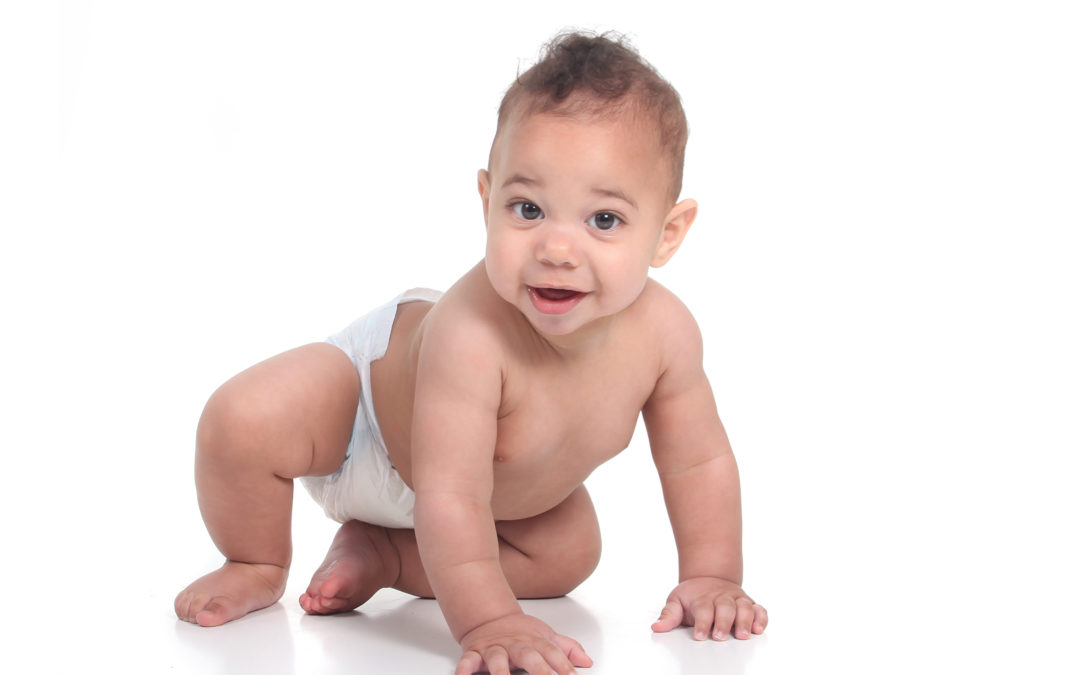Today we wanted to share a guest blog post by our friends at The Inspired Treehouse. Lauren and Claire are pediatric physical and occupational therapists and the co-founders of The Inspired Treehouse where they share information, tips, activities, and strategies to help readers conquer common developmental issues that come up for kids. Learn more at theinspiredtreehouse.com!
Most babies usually crawl on all fours between the ages of 6-9 months.
Once they can roll and sit up on their own, they begin to realize their potential for getting from point A to point B. And suddenly, a whole new world opens up to them as they begin to creep along on their stomachs, scoot forward using one leg to propel themselves, and even put several different movements together, gradually inching their way across the floor.
As parents, we “ooh” and “ahh” at our little one’s newfound mobility and independence. Look how cute he is! Look how fast she can go! But as pediatric therapists, we see crawling as more than just a cute rite of passage.
Why is crawling so important?
Crawling encourages the development of so many developmental skills including:
- Bilateral coordination – The coordinated use of both sides of the body together to perform a task.
- Reciprocal arm and leg movements – Alternating patterns of movement using both sides of the body.
- Strength – Crawling promotes neck and core strength, arm strength, and hand strength.
- Balance
- Hand-eye coordination
- Motor planning
- Weightbearing through the hands
- Integration of primitive reflexes – A set of innate and involuntary movements infants make in response to certain stimuli.
My child never learned to crawl
So what about babies who seem to skip right over this important developmental milestone?
Babies who haven’t spent a lot of time on the floor or in tummy time may never learn to crawl. Some babies are in “containers” (e.g. car seat, carrier, swing) for extended periods of time during this crucial developmental window, meaning that they may not develop the strength and skills they need to crawl.
Other times, parents feel pressured to compare their babies to other kids. They may want their babies to walk “early”, holding their hands and practicing standing and walking before their babies are developmentally ready. This can lead to babies who learn to walk before getting all of that important tummy time, scooting experience, and crawling practice.
Physical and neurological conditions may also prevent a child from learning to crawl, as in children with Cerebral Palsy.
In some children, the primitive reflexes have not been fully integrated, which leads to difficulty with controlling and coordinating the movements needed for crawling.
Sensory development can also play a role in whether a child learns to crawl. Some children struggle with vestibular processing, which can lead to issues with coordination and balance. The visual system can also impact a baby’s ability to crawl, as he judges the distance between himself and the obstacles around him. Children who have difficulty with tactile processing may be reluctant to be on the floor or they may be unwilling to crawl over various surfaces.
What can I do to support my child?
No doubt about it, the single best way to support a baby in learning to crawl is to ensure that she spends plenty of time lying in all different positions on the floor (with supervision, of course). This means tummy time, sidelying, and lying on her back while looking at your face, reading books, or trying to reach for toys.
If your child is older and never met this developmental milestone and you continue to see deficits in the skills described above, it’s not too late to help him start to develop these foundation skills through fun and playful activities.
T-Birds
Creating proper extension and posture is an important aspect of being able to crawl, as well as perform other upright movements effectively.
Baby Crawl
The basic crawl pattern helps set the stage for a variety of other aspects of movement and sensory development.
Sensory Prep for the Crawl
Once a child has developed the basic crawl pattern, help them develop body and movement awareness by changing speed, direction, and other aspects of movement.
Imaginary Animal Crawl
Combining imagination with the crawling pattern aids in the development of coordination, body awareness, and strength!
Craig Valency, MA, CSCS, president and co-founder of SPIDERfit, has been a personal trainer for the last 11 years. He is currently working at Fitness Quest 10 in San Diego, an elite personal training and athletic conditioning facility. He specializes in youth strength and conditioning programs that promote physical literacy, injury prevention and optimal performance. Along with training youths from 6 to 18 years of age for general fitness, Craig has also worked with some of the top junior tennis players in the world. He has been a physical education consultant for the Stevens Point school district in Wisconsin for the last 3 years, helping revamp the district wide programming for the K-12 PE curriculum. Craig earned his bachelor degree from UCLA, and Masters Degree in Kinesiology from San Diego State University.





Connect with SPIDERfit!